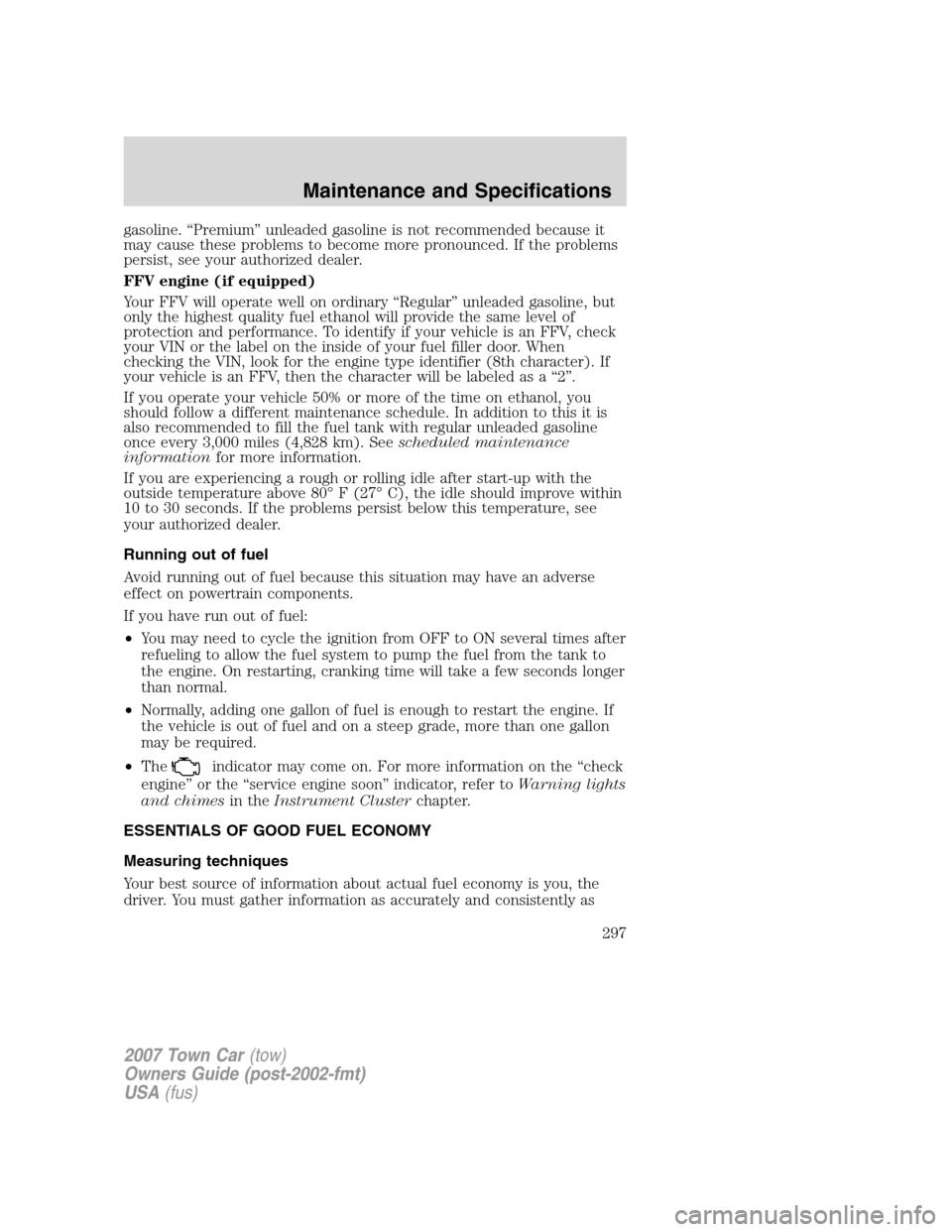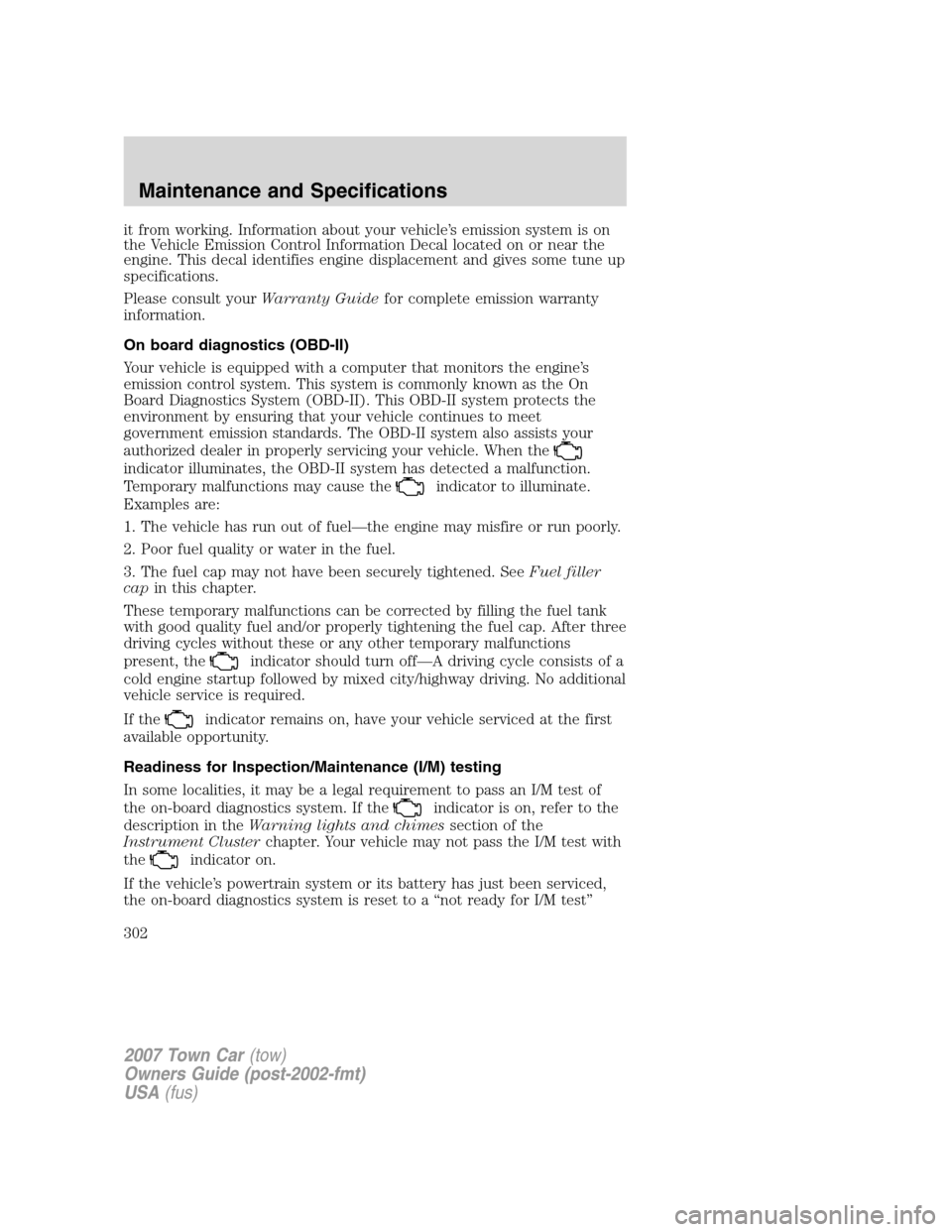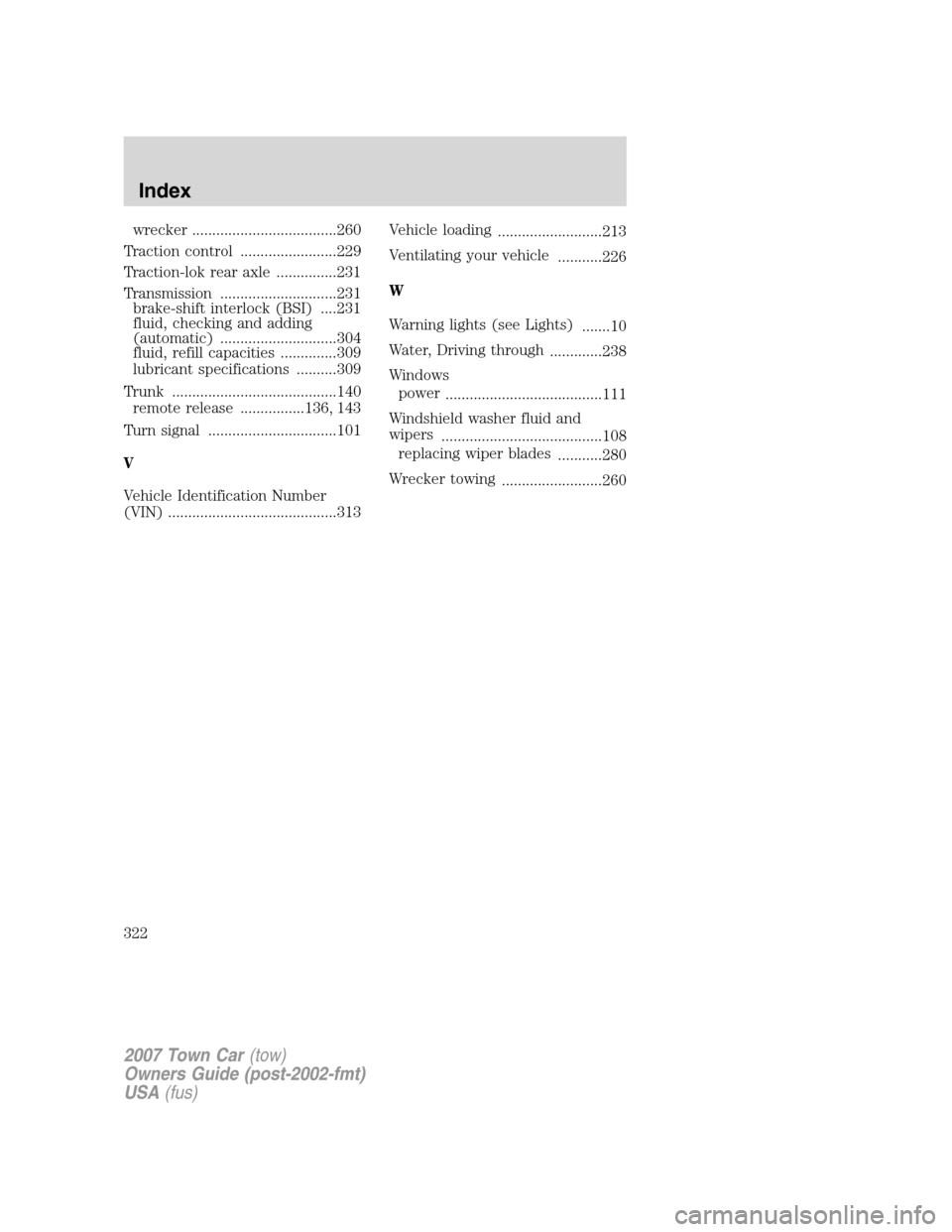Page 297 of 328

gasoline. “Premium” unleaded gasoline is not recommended because it
may cause these problems to become more pronounced. If the problems
persist, see your authorized dealer.
FFV engine (if equipped)
Your FFV will operate well on ordinary “Regular” unleaded gasoline, but
only the highest quality fuel ethanol will provide the same level of
protection and performance. To identify if your vehicle is an FFV, check
your VIN or the label on the inside of your fuel filler door. When
checking the VIN, look for the engine type identifier (8th character). If
your vehicle is an FFV, then the character will be labeled as a “2”.
If you operate your vehicle 50% or more of the time on ethanol, you
should follow a different maintenance schedule. In addition to this it is
also recommended to fill the fuel tank with regular unleaded gasoline
once every 3,000 miles (4,828 km). Seescheduled maintenance
informationfor more information.
If you are experiencing a rough or rolling idle after start-up with the
outside temperature above 80° F (27° C), the idle should improve within
10 to 30 seconds. If the problems persist below this temperature, see
your authorized dealer.
Running out of fuel
Avoid running out of fuel because this situation may have an adverse
effect on powertrain components.
If you have run out of fuel:
•You may need to cycle the ignition from OFF to ON several times after
refueling to allow the fuel system to pump the fuel from the tank to
the engine. On restarting, cranking time will take a few seconds longer
than normal.
•Normally, adding one gallon of fuel is enough to restart the engine. If
the vehicle is out of fuel and on a steep grade, more than one gallon
may be required.
•The
indicator may come on. For more information on the “check
engine” or the “service engine soon” indicator, refer toWarning lights
and chimesin theInstrument Clusterchapter.
ESSENTIALS OF GOOD FUEL ECONOMY
Measuring techniques
Your best source of information about actual fuel economy is you, the
driver. You must gather information as accurately and consistently as
2007 Town Car(tow)
Owners Guide (post-2002-fmt)
USA(fus)
Maintenance and Specifications
297
Page 302 of 328

it from working. Information about your vehicle’s emission system is on
the Vehicle Emission Control Information Decal located on or near the
engine. This decal identifies engine displacement and gives some tune up
specifications.
Please consult yourWarranty Guidefor complete emission warranty
information.
On board diagnostics (OBD-II)
Your vehicle is equipped with a computer that monitors the engine’s
emission control system. This system is commonly known as the On
Board Diagnostics System (OBD-II). This OBD-II system protects the
environment by ensuring that your vehicle continues to meet
government emission standards. The OBD-II system also assists your
authorized dealer in properly servicing your vehicle. When the
indicator illuminates, the OBD-II system has detected a malfunction.
Temporary malfunctions may cause the
indicator to illuminate.
Examples are:
1. The vehicle has run out of fuel—the engine may misfire or run poorly.
2. Poor fuel quality or water in the fuel.
3. The fuel cap may not have been securely tightened. SeeFuel filler
capin this chapter.
These temporary malfunctions can be corrected by filling the fuel tank
with good quality fuel and/or properly tightening the fuel cap. After three
driving cycles without these or any other temporary malfunctions
present, the
indicator should turn off—A driving cycle consists of a
cold engine startup followed by mixed city/highway driving. No additional
vehicle service is required.
If the
indicator remains on, have your vehicle serviced at the first
available opportunity.
Readiness for Inspection/Maintenance (I/M) testing
In some localities, it may be a legal requirement to pass an I/M test of
the on-board diagnostics system. If the
indicator is on, refer to the
description in theWarning lights and chimessection of the
Instrument Clusterchapter. Your vehicle may not pass the I/M test with
the
indicator on.
If the vehicle’s powertrain system or its battery has just been serviced,
the on-board diagnostics system is reset to a “not ready for I/M test”
2007 Town Car(tow)
Owners Guide (post-2002-fmt)
USA(fus)
Maintenance and Specifications
302
Page 320 of 328

bulb replacement
specifications chart ................102
daytime running light ...............98
fog lamps ...................................98
headlamps .................................97
headlamps, flash to pass ..........98
instrument panel, dimming .....99
interior lamps .................101–103
replacing bulbs .......................103
Lane change indicator
(see Turn signal) ......................101
Lights, warning and indicator ....10
anti-lock brakes (ABS) ..........227
Load limits .................................213
Locks
childproof ................................140
doors ........................................138
Lubricant specifications ...........309
Lug nuts ....................................255
Lumbar support, seats .............156
M
Message center .........................124
english/metric button .............129
system check button ..............128
warning messages ...................132
Mirrors .......................................113
automatic dimming rearview
mirror ......................................113
fold away .................................114
heated ......................................114
programmable memory ..........144
side view mirrors (power) .....113
Moon roof ..................................119
Motorcraft parts ........274, 291, 307
N
Navigation system .......................30cd functions ..............................47
destination mode ......................71
DVD location .............................91
map mode .................................51
quick start .................................32
radio functions ..........................39
O
Octane rating ............................296
Oil (see Engine oil) ..................280
P
Parking brake ............................228
Parts (see Motorcraft parts) ....307
Passenger Occupant
Classification Sensor .................162
Pedals (see Power adjustable
foot pedals) ...............................114
Power adjustable foot pedals ...114
Power distribution box
(see Fuses) ...............................245
Power door locks ......................138
Power mirrors ...........................113
Power point ...............................110
Power steering ..........................230
fluid, checking and adding ....303
fluid, refill capacity ................309
Power trunk ......................135–136
Power Windows .........................111
R
Radio ................................15, 18, 24
Rear window defroster ...............96
Relays ........................................242
2007 Town Car(tow)
Owners Guide (post-2002-fmt)
USA(fus)
Index
320
Page 322 of 328

wrecker ....................................260
Traction control ........................229
Traction-lok rear axle ...............231
Transmission .............................231
brake-shift interlock (BSI) ....231
fluid, checking and adding
(automatic) .............................304
fluid, refill capacities ..............309
lubricant specifications ..........309
Trunk .........................................140
remote release ................136, 143
Turn signal ................................101
V
Vehicle Identification Number
(VIN) ..........................................313Vehicle loading
..........................213
Ventilating your vehicle
...........226
W
Warning lights (see Lights)
.......10
Water, Driving through
.............238
Windows
power
.......................................111
Windshield washer fluid and
wipers
........................................108
replacing wiper blades
...........280
Wrecker towing
.........................260
2007 Town Car(tow)
Owners Guide (post-2002-fmt)
USA(fus)
Index
322